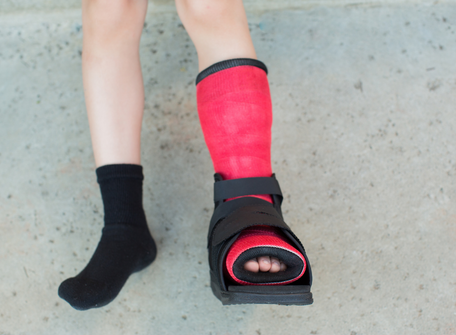The ankle-foot orthotic (AFO) is usually fitted to a child with cerebral palsy and spasticity in the ankles, feet, and legs. Children who have not yet mastered standing or sitting upright, as well as those who cannot bear weight on their feet, are also affected.
AFOs are used for the following reasons:
- To correct the ongoing muscular pull caused by spasticity in the feet and ankles
- For these parts, it is important to avoid distortions in the formation of the joints.
Apparently, there is also an underlying belief that a child will be able to stand and walk if their feet and ankles are forced to be “straight.”
Foot and ankle distortions are understandable and important to eliminate. AFOs should be used where possible, but whether they are the best method for achieving this goal deserves further consideration. To find answers, we may want to examine how children who do not have special challenges learn to use their feet and ankles. In order for children with special challenges to learn to use their feet for standing and walking, their nervous systems will have to go through a similar process to other children.
Child Development Without Special Challenges
In the first few months following birth, a typical baby will have trouble bearing weight on her feet. It is normal for her to move her legs in a variety of directions spontaneously during that period.
It is inevitable that the child’s feet will touch people or objects nearby as a result of these movements. A typical baby will apply pressure to Mom, Dad, the crib mattress, or any other surface with their feet, causing forces to travel through their skeleton repeatedly before they attempt to stand.
It is common for a child’s feet to touch and press into these surfaces from all directions: both its sole and its top, both its inside and its outer border. As a result, the feet are in contact with the world in many different ways. As time goes on, the baby will be able to grasp her feet and bring them to her mouth. This is an important developmental stage because the baby does not need to use his feet in a particular way. When she learns to crawl on her belly, she often discovers that pushing on her toes propels her forward.
Her feet continuously experience new forms of movement in the context of evolving new movement configurations as she acquires more and more movement skills. It is through continuous variations in movement, through kinesthetic experiences, through interactions between feet and their surroundings, and through the different outcomes which result from these movements and interactions that the baby learns to KNOW her feet, and gradually learns to control them.
Legs, Ankles, And Feet With Spasticity
Due to spasticity, the child whose feet, ankles, and legs are spastic is deprived of discovering his own feet as other children do. Baby’s spontaneous and random movements are stopped by spasticity. A child who does not experience varied movements does not have the wealth of sensations, feelings, and outcomes that he needs to form patterns of voluntary movements in his ankles and feet.
It’s important to remember that children learn to use their feet as they learn to use their bodies as a whole. A baby learns to use his feet effectively while also learning to use his back and pelvis, carry his head, orient himself in space, and bear weight on his hands and arms.
Similarly, brain development regarding the whole body requires great variability in random and spontaneous movement and experiences, just as it does for the development of the brain’s ability to organize foot movement. As a result of this wide range of experience, the baby’s brain is able to organize the whole body and to coordinate the movements of the feet with those of the rest of the body.
Often, children with spastic feet and ankles lack the opportunity to form well-organized movements throughout their bodies. Because of this, the brain cannot form proper dynamic relationships between the feet, ankles, and the whole body. The child has a hard time connecting with her feet and putting them to use in an intentional and effective manner as a result.
The Impact of AFOs
By using AFOs, a static view of the body is taken. Putting braces on the feet, ankles, and legs of a child with cerebral palsy to force them into a more “correct” or “normal” position only exacerbates the underlying issue. Even less variability in movement will be possible when the feet and ankles are fixed in braces. Children are less likely to sense and feel the inside of their braces since the environment becomes frozen.
With AFOs on, no matter how the child organizes and moves her body, the legs remain fixed, preventing proper dynamic relationships between the feet, ankles, and the rest of the body. Through self-correction and approximations, the child cannot learn how to use her feet through the use of AFOs.
Foot orthoses: How Do They Work?
The purpose of foot orthoses is to support the feet and improve the posture of the feet. Additionally, orthotics relieve pain by putting the foot in a better position. The right orthotic will reduce muscle workload and provide relief if a muscle is strained or hurting.
The majority of foot orthoses benefit patients who have chronic foot or leg problems that prevent them from walking properly. Foot orthotics, for example, may be prescribed by a podiatrist to patients with persistent calluses to redistribute their body weight or to athletes with foot problems.
Ankle Foot Orthotics: How to Care for Them
Your ankle-foot orthosis can get dirty quickly since you wear it for long periods of time. Wash it regularly with soapy water and a damp cloth to keep it clean. Before re-wearing your AFO, ensure it is completely dry.
The velcro straps can be kept clean by brushing out any lint or hair buildup using a wire brush, toothbrush, or fine-toothed comb by mixing one tablespoon of unscented bleach in a gallon of warm water.
Our Range of Orthotics & Prosthetics at Hope AMC include:
Cranial Helmets
As part of helmet molding therapy, or cranial orthosis, babies are fitted with a special helmet to correct their skull shape.
A cranial remolding procedure may be prescribed to correct the shape of the baby’s head if they have plagiocephaly, brachycephaly, or scaphocephaly.
Upper Extremity Orthotics
- Wrist-hand orthosis.
- Wrist cock-up splint.
- Wrist cock-up splint.
- Wrist cock-up splint.
- Resting hand orthosis.
- Ulnar or humeral fracture brace.
- Shoulder abduction restraint.
- Elbow splint.
- Figure of eight.
- Shoulder immobilizer.
Lower Extremity Orthotics
- Ankle foot orthosis.
- Carbon fiber braces.
- Functional electrical stimulation for foot drop.
- Knee ankle foot orthosis.
- Reciprocating gait orthosis.
- Stance control knee ankle foot orthosis.
- Hip knee ankle foot orthosis.
- Controlled ankle motion walker.
- Tibial and femoral fracture brace.
- Knee immobilizer.
- Post-op range of motion knee orthosis.
- Hip abduction orthosis.
Pediatric Orthotics
- Pediatric WalkAide system.
- Pediatric knee ankle foot orthosis.
- Pediatric ankle foot orthosis.
- Tuning ankle foot orthosis.
- UBC foot orthosis.
- Pediatric supra-malleolar orthosis.
- Pediatric thoraco lumbar sacral orthosis.
- Foam and plastic hip abduction orthosis.
- Adjustable hip abduction orthosis.
- Wheaton brace.
- Cranial molding helmet.
- Pavlov harness.
- Denis Browne bar.
- Sitting/walking/sitting hip orthosis.
Spinal
- Thoracic-lumbar-sacral orthosis.
- Semi-rigid thoracic-lumbar-sacral orthosis.
- Semi-rigid lumbar-sacral orthosis.
- Cervical thoracic-lumbar-sacral orthosis.
Prosthetics
- Prosthetic Arm and Prosthetic Hand
- Prosthetic Leg and Prosthetic Foot
- Pediatric Prosthetics
Our pediatric ankle foot orthosis team can help your little one today! Feel free to contact us at +971-529997075 or email at [email protected]


